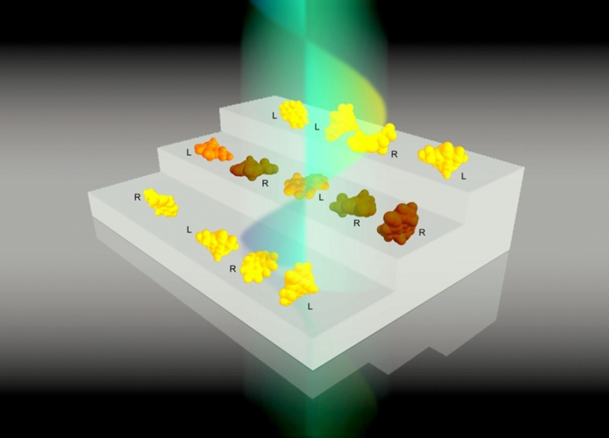Optical chirality
Chiral objects interact asymmetrically with chiral fields. For example, a chiral molecule is excited at slightly different rates when exposed to left- or right-circularly polarized light (CPL), an effect called circular dichroism. Circular dichroism (CD) is widely used to characterize organic and biological compounds.
Chiroptical effects are typically very small, because the wavelength of light is so much larger than the size of most molecules. The electromagnetic field undergoes a nearly imperceptible twist over molecular dimensions.
To couple more strongly to molecular chirality, one should increase the chirality, or twistiness, of the electromagnetic field. We invented a quantity, optical chirality, that quantifies the degree of chiral dissymmetry in electromagnetic fields. We further showed how one could engineer electromagnetic fields to maximize the chiral dissymmetry.
References
- D. Yang, A.E. Cohen, Chirality-dependent friction of bulk molecular solids, Langmuir, 30, 9972- 9976, 2014.
- Y. Tang, L. Sun, A. E. Cohen, Chiroptical hot spots in twisted nanowire plasmonic oscillators, Applied Physics Letters, 102, 043103, 2013. Supporting Information.
- N. Yang, A. E. Cohen, Local geometry of electromagnetic fields and its role in molecular multipole transitions, J. Phys. Chem. B, 115, 5304-5311, 2011.
- Y. Tang, A. E. Cohen, Enhanced enantioselectivity in excitation of chiral molecules by superchiral light, Science, 332, 333-336, 2011. Supporting Online Material
- Y. Tang, A. E. Cohen, Optical chirality and its interaction with matter, Phys. Rev. Lett (cover story), 104,163901, 2010.
- Y. Tang, T. A. Cook, A. E. Cohen, Limits on fluorescence detected circular dichroism of single helicene molecules, J. Phys. Chem. A, 113, 6213-6216, 2009.
- N. Yang, Y. Tang, and A. E. Cohen, Spectroscopy in sculpted fields, Nano Today, 4, 269-279, 2009.

Trapping single molecules in solution
The Anti-Brownian ELectrokinetic trap (ABEL trap) is a device for trapping and manipulating single molecules in solution at room temperature. It couples fluorescence microscopy to real-time electrokinetic feedback to control the motion of individual molecules. By actively canceling a molecule's Brownian motion, individual free-floating molecules can be observed for extended times. The ABEL trap has been used to trap and study fluorescent quantum dots, molecules of DNA, fluorescently labeled lipid vesicles, single virus particles, single proteins, and even single dye molecules.
References
- A. P. Fields, A. E. Cohen, Optimal tracking of a Brownian particle, Optics Express, 20, 22585-22601, 2012.
- A. E. Cohen, A. P. Fields, The cat that caught the canary: what to do with single-molecule trapping, ACS Nano, 5, 5296-5299, 2011.
- A. P. Fields, A. E. Cohen, Electrokinetic trapping at the one nanometer limit, PNAS, 108, 8937-8942, 2011.
- A. E. Cohen and W. E. Moerner, Anti-Brownian Traps, in Encyclopedia of Biophysics, G. C. K. Roberts (Ed.) (Springer, Berlin, Heidelberg, appearing 2012).
- A. P. Fields and A. E. Cohen, Anti-Brownian traps for studies on single molecules, Methods in Enzymology, 475, 149-174, 2010.
- Y. Jiang, Q. Wang, A. E. Cohen, N. Douglas, J. Frydman, W. E. Moerner, Hardware-based anti-Brownian electrokinetic trap (ABEL trap) for single molecules: Control loop simulations and application to ATP binding stoichiometry in multi-subunit enzymes, Proc. SPIE, 7038, 703807, (2008)
- A. E. Cohen, W. E. Moerner: Controlling Brownian motion of single protein molecules and single fluorophores in aqueous buffer, Opt. Express, 16, 6941-6956, 12 May 2008.
- A. E. Cohen and W. E. Moerner: Suppressing Brownian motion of individual biomolecules in solution, PNAS, 103, 4362-4365, 14 Mar. 2006. Journal link and Supporting Material and Movies.
- A. E. Cohen and W. E. Moerner: An all-glass microfluidic cell for the ABEL trap: fabrication and modeling, Proc. SPIE 5930, 2005.
- A. E. Cohen and W. E. Moerner: The Anti-Brownian Electrophoretic trap (ABEL Trap): tabrication and software, Proc. SPIE 5699, 2005.
- A. E. Cohen and W. E. Moerner: Method for trapping and manipulating nanoscale objects in solution , Appl. Phys. Lett. 86, 093109, 28 Feb. 2005.
